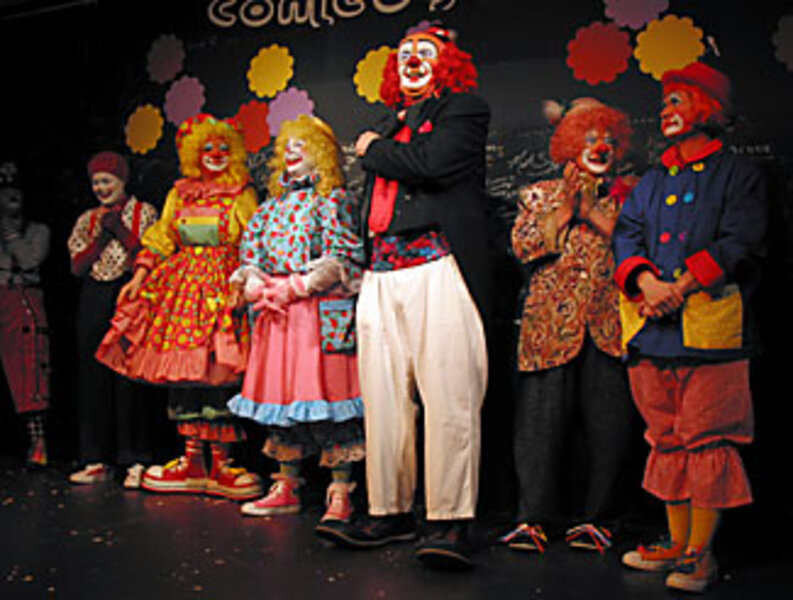Everyone's the class clown at this school
Loading...
Bob Kreidler looks at his clown students. He examines their hair, clothing, and makeup.
"I gotta tell you, the purple doesn't work for me," he tells one student. "It's far too dark for the brightness of your character."
He moves on to another student. "This is a well-designed face," he says. "But ask yourself, 'Does it fit the face of the character I created?' "
Mr. Kreidler is headmaster of the Ohio College of Clowning Arts in Akron, now in its 20th year of training aspiring clowns. That's right. There are schools devoted to teaching people how to be clowns! The college's 30-week program covers everything from makeup to the business of clowning.
Some of the students pursue clowning to get a needed change from their daytime routines. Others enroll because they've had a lifelong fascination with clowning and are now pursuing their dreams to become clowns. Still others want to earn money through clowning jobs or perform at charitable events as a way to give back to the community.
Most of them will work regular, full-time jobs and only part time as clowns. But being a part-time clown doesn't take away from what clowns are doing, which is "entertaining from the heart," says Rick Zaborac, president of the World Clown Association, an organization dedicated to promoting the art of clowning.
Mr. Kreidler earns his living from teaching aspiring clowns and by clowning, storytelling, speaking publicly, and doing television commercials. He appears as the clown Rufus D. Dufus at companies, corporate shows, festivals, and schools.
But he wasn't always Rufus D. Dufus. Many years ago, he was a professional Army officer and later became an educator. Then, in 1983, at a program where two other educators were sharing their clowning expertise, he volunteered to have his face painted like a clown. That was it: Mr. Kriedler had found his passion.
He tried to learn more about professional clowning but didn't know where people could easily train to become clowns. So he studied acting and improvisation.
Six years later, he became an entertainer when he left an education job in Ohio. He first did storytelling, clowning, theater, and speaking engagements. Then he returned to education – this time to teach clowning. His first clown class graduated in 1990.
These days, Mr. Kreidler is still teaching students how to apply makeup, develop entertaining routines, and be professional. His students learn that clowns make fun of themselves or other clowns, but they never make fun of the audience.
He also doesn't believe that clowns must rely on creating balloon sculptures to entertain. Balloons are fine, he says, but the clown, not the props, should be more engaging.
"You can tell a true clown if [he or she] can go out and entertain without props and be funny," Mr. Zaborac says.
Clowns, Mr. Kreidler adds, need to be interesting, and their skits should tell a story. Mike Salvino agrees. He graduated from the Ohio College of Clowning Arts and now teaches there. "You just can't go out and be goofy," he says. "There has to be a beginning and middle and end to your act."
Darlene Kamp, another graduate, developed a recital routine in which everything goes wrong. Her music falls off the music stand. When the stand collapses, she kneels on the floor to read the music. Eventually, she pulls up the stand, secures it with yellow duct tape, and smiles triumphantly.
"[The routine] doesn't happen with just the idea or even with an initial acting out at class," says Ms. Kamp. "It goes through grueling refinement and trials to become a polished piece that looks like it is 'just happening.' " Angie Salvino is 14 and has long, auburn hair. "I just look pretty normal, just like any other girl," she says. Normal, that is, unless she's wearing a purple and blue wig, white makeup, and a red heart painted on the tip of her nose.
Angie is a professional clown and performs with her older brothers, Vince and Tony, and her father, Mike. As the Salvino Family Show, the four family members "clown around" at schools, birthday parties, and other events.
Angie started clowning at age 7 because she saw how much fun her brothers and dad had doing it. "They all could act silly," she says. "They looked like they were enjoying themselves."
Her clown persona is "Sweets," a kind, silly clown who has to be a leader to the less competent grown-up clowns. "Her function with the troupe is to be the only 'adult' on stage," says Bob Kreidler. "Sweets is always trying to pick up the pieces that these [other clowns] leave behind...."
As "Sweets," Angie says she tries to be open and outgoing. "At first, I was really scared that the audience wouldn't like me, that I wasn't good enough," she says. "But, after a while, I learned that they're not going to hate you, that they think it's fun."





